- Fresh Short Taken in AUD/USD (see below)
- OECD warnings should be a concern to markets
- Risk correlated assets rallying but we see no reason for it
- Price action classified as short-term corrective
- USD should continue to find bids on dips
- Japanese Yen at risk for major depreciation over medium and longer-term
- Looking for breakdown in familiar correlation between Yen and risk
- UK house prices rise; mortgage approvals improve; Eurozone confidence flat
- Italian auction results solid; helps to bolster Euro intraday
Many of you are wondering why risk correlated assets continue to rally so aggressively over the past few sessions and why the USD has come back under pressure. You are not alone – I usually avoid using “I” in my analysis and prefer sticking to the royal “we,” but this time I am so perplexed with the price action that I need to use “I.” Thus far, headlines out of the Eurozone have been far from comforting, and the latest warnings from the traditionally conservative OECD on the region should send additional chills down investors’ spines.
Relative performance versus the USD on Tuesday (as of 11:45GMT)
- AUD +1.48%
- NZD +1.17%
- CHF +0.81%
- CAD +0.78%
- GBP +0.57%
- EUR +0.56%
- JPY +0.36%
The OECD is an institution that is not known for deviating too far away from consensus. Trader should pay attention to its comments that the Eurozone debt crisis has become the biggest threat to the global economy, and that a break up can not be ruled out. The institution goes on to say that “‘The ECB should buy bonds, and set a limit to yields or a floor to bond value, so that markets know there's a counter party ready to trade at that level.’ In order to stop the contagion, policy makers need to secure ‘credible and substantial increases’ in the capacity of the European Financial Stability Fund, the euro zone's bailout vehicle, together with a greater use of the ECB's balance sheet. ‘The present situation is worse than in 2009.’”
Throw in the ongoing threat of downgrade from rating agencies, continued widening of Eurozone bond spreads to record levels, and a banking system that looks like it is on the verge of collapse, and we find it very difficult to rationalize a market that is content to buy back into risk correlated assets. We would venture to say that we are as equally perplexed with the latest rally in risk correlated markets as we are with the idea that clients at MF Global are not able to recover their highly protected and segregated funds. While the MF Global situation is not Eurozone centric, it should not be overlooked.
And yet, risk correlated assets are well bid over the past few sessions and market participants are seemingly content on either booking profits on short risk positions, or dare I say actually buying back into risk. We have a hard time accepting the latter proposal and therefore would simply classify this latest price action as nothing more than some corrective relief to fill the gap from the previous week’s thin holiday trade before eventually resuming the more justified underlying risk off trend. With this in mind, we continue to project broad based weakness in all risk correlated assets, with the US Dollar as the primary beneficiary of these flows. There is simply no other currency that can handle risk liquidation flows as well as the US Dollar, and we even project significant weakness in the Yen over the medium and longer-term.
Our view on the Yen is far from conventional, but we are calling for a breakdown in familiar correlations to the point that we could actually see then Yen underperform across the board in a risk off market environment. This would be counterintuitive and imply that serious bouts of risk liquidation going forward would see the Yen crosses moving higher rather than lower, and this is exactly what we are projecting. In our humble opinion (my humble opinion), I see a situation where Japan no longer can absorb the appreciation in the Yen on safe-haven flows and external non-Japan specific fundamentals, and will look to more aggressively intervene on behalf of its currency to prevent additional appreciation. This should play out in an even stronger way than had been seen with the Swiss Franc several weeks back, and as such, one of our favorite trades heading into 2012 is to look to build short Yen positions.
To be safe, we think the best strategy over the coming months is to play the long USD/JPY trade rather than long other Yen crosses, as we see less downside risk in this play. While it is also true that there could be less upside potential here, we still think there is plenty of upside that the trade is worth serious consideration. Should we be wrong in our view and additional risk liquidation continues to benefit the Yen, the USD will also likely benefit equally if not more going forward on risk liquidation flows, so our downside in this situation should be limited. If we are wrong on the other side and market somehow turn around sharply and we see a resurgence in risk appetite, then we will be happily wrong, as the development will likely open the door for a more aggressive selling in the Yen on a move back into risk correlated assets. Finally, while the long USD/JPY position does not offer anything exciting in terms of yield, it is still classified as a carry trade (albeit a baby carry) which means that holding the position on a daily basis earns interest on the favorable yield differential.
At the end of the day, it seems as though market participants are finding comfort in the fact that governments are coming up with solutions to deal with the crisis and are rewarding these efforts by buying back into risk. But the logic makes no sense to us, and in our opinion, the fact that there needs to be such an aggressive response by governments to intervene is a clear sign that things are not good. We are reminded of a bit performed by comedian Chris Rock - the comedian talks of a parent who proudly announces to everyone “I take care of my kids.” Rock’s response to this type of obnoxious remark is “you’re supposed to take care of your kids you [insert profanity]! What do you want… a cookie??” The same holds true in our opinion with the crisis. Why should we reward governments for coming up with resolutions to a crisis that they are supposed come up with? In fairness, we are less critical of the governments in this situation and more taken with the reaction of markets which applaud their government for taking action that is needed. Buying back into risk therefore makes absolutely no sense to us at this point and we continue to project a resumption of pressure on these assets and broad based flow of funds into the safe haven US Dollar.
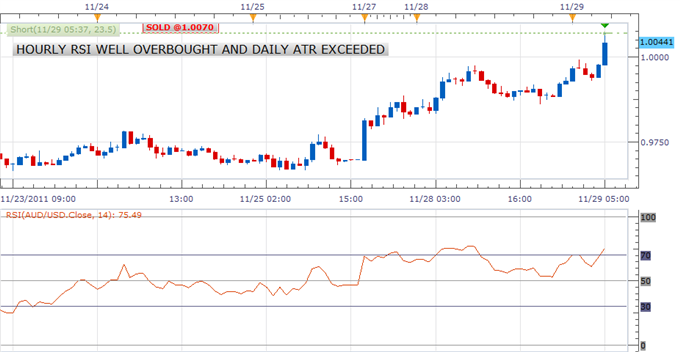
NEW TRADE: For today, our strategy has triggered a new trade in AUD/USD. While we are already short from several weeks back at 1.0550 (booked profit on half at 1.0150), we have decided to build back into the position following the latest surge beyond parity. Overall, we see this market in the process of carving a major longer-term top, with any rallies viewed as formidable sell opportunities in anticipation of a bearish resumption and eventual break back below the critical October lows at 0.9385. Technically, the market looks exhausted intraday after the hourly RSI boomed towards 80 and the daily ATR (Average True Range) was well exceeded. Ideally, risks for additional upside on Tuesday are limited, and the market should start to pullback. We will look for this intraday pullback to build into something more significant, with a break back below 0.9860 to confirm and accelerate. We will only exit the short position should the market ever put in a daily close above 1.0250 (5pm New York). We also recommend that the position be un-leveraged. Our risk on this specific trade is less than 2% of total equity.
ECONOMIC CALENDAR
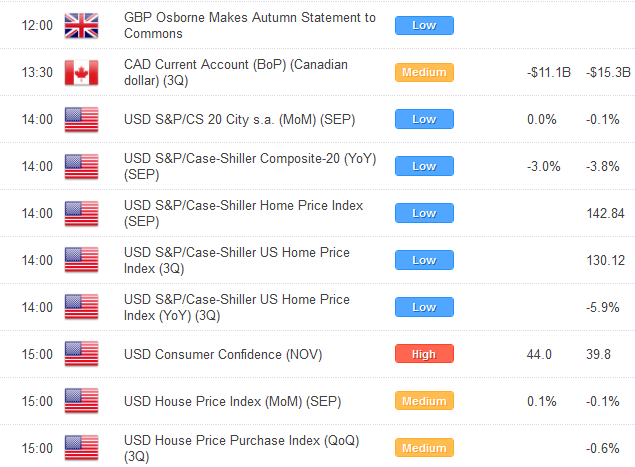
TECHNICAL OUTLOOK

EUR/USD: The market remains under some intense pressure and is now fixated on a retest of the key October lows at 1.3145. Look for any rallies to be well capped below 1.3500 on a daily close basis, while ultimately, only back above 1.3870 would negate outlook. Once 1.3145 is taken out, it will negate the corrective October price action and should result in a more aggressive bout of selling into the 1.2000’s. We continue to project weakness over the coming weeks into the lower 1.2000’s as per the monthly chart.
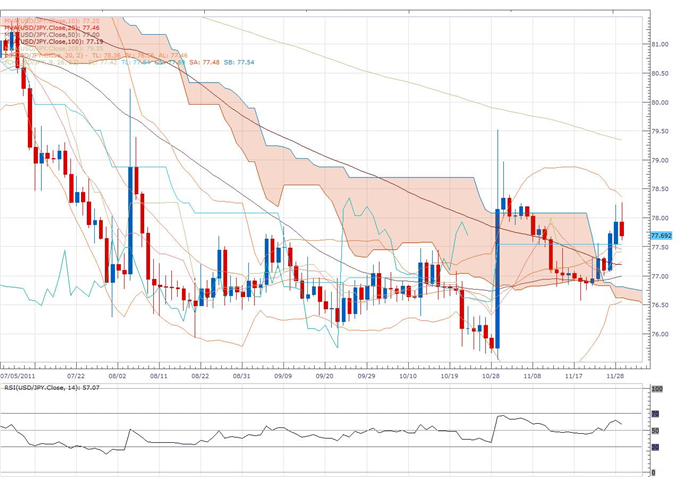
USD/JPY:The market has managed to successfully hold above the bottom of the daily Ichimoku cloud to further strengthen our constructive outlook and we look for the formation of a inter-day higher low by 76.55 ahead of the next major upside extension back towards and eventually through the recent multi-day highs by 79.55. Ultimately, only a close back below the bottom of the Ichimoku cloud would negate outlook and give reason for pause.
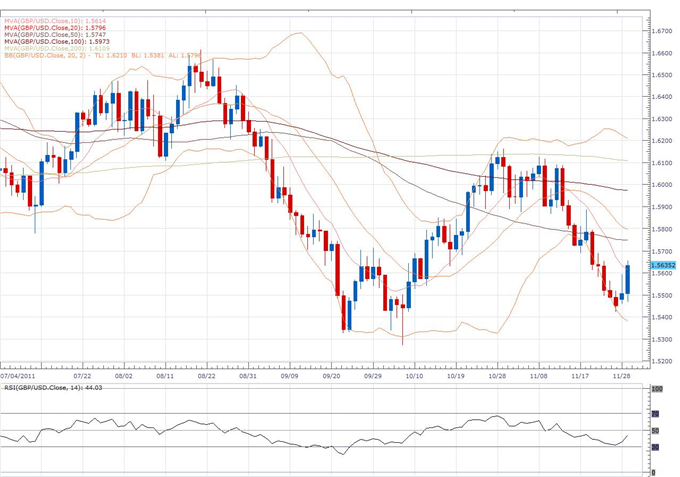
GBP/USD: The latest daily close below 1.5625 further confirms our bearish outlook and should now open the door for a bearish resumption back towards the key October lows at 1.5270 over the coming days. Next key support comes in at 1.5400, while any intraday rallies are expected to be very well capped below 1.5800 on a daily close basis.
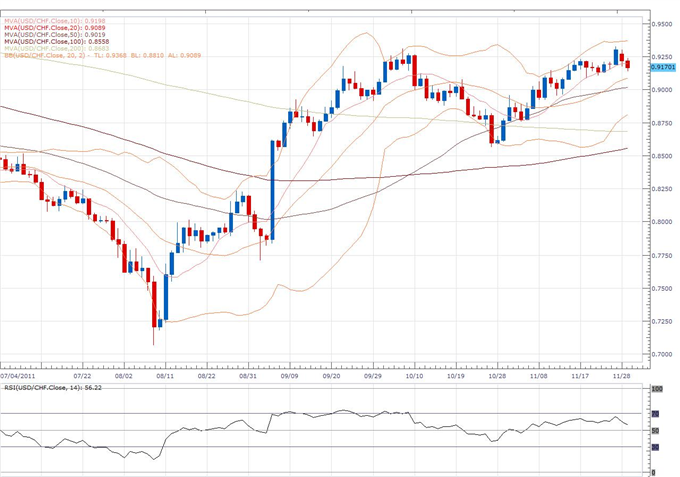
USD/CHF: The previous weekly break above the critical October highs at 0.9315 is significant and now opens the door for the next major upside extension over the coming weeks back towards parity. Daily studies are looking slightly stretched at current levels, so we would not rule out the potential for some corrective selling, but ultimately, look for any setbacks to be well supported in the 0.9000 area, where a fresh higher low is sought out.
--- Written by Joel Kruger, Technical Currency Strategist
To be added to Joel Kruger’s distribution list, send an email with subject line “Distribution List” to jskruger@dailyfx.com